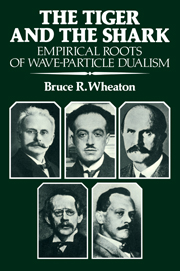Book contents
- Frontmatter
- Contents
- Foreword by Thomas S. Kuhn
- Preface
- Notes on sources
- 1 Introduction
- Part I The introduction of temporal discontinuity, 1896–1905
- 2 The electromagnetic impulse hypothesis of x-rays
- 3 The analogy between γ-rays and x-rays
- Part II Ionization and the recognition of paradox, 1906–1910
- Part III Seeking an electrodynamic solution, 1907–1912
- Part IV Interference of x-rays and the corroboration of paradox, 1912–1922
- Part V The conceptual origins of wave–particle dualism, 1921–1925
- Epilogue: The tiger and the shark
- Bibliography
- Index
3 - The analogy between γ-rays and x-rays
Published online by Cambridge University Press: 04 August 2010
- Frontmatter
- Contents
- Foreword by Thomas S. Kuhn
- Preface
- Notes on sources
- 1 Introduction
- Part I The introduction of temporal discontinuity, 1896–1905
- 2 The electromagnetic impulse hypothesis of x-rays
- 3 The analogy between γ-rays and x-rays
- Part II Ionization and the recognition of paradox, 1906–1910
- Part III Seeking an electrodynamic solution, 1907–1912
- Part IV Interference of x-rays and the corroboration of paradox, 1912–1922
- Part V The conceptual origins of wave–particle dualism, 1921–1925
- Epilogue: The tiger and the shark
- Bibliography
- Index
Summary
The γ-rays are very penetrating Röntgen rays [produced by] the expulsion of the β … particle.
The discovery of x-rays reduced much natural reluctance on the part of physicists to report other discoveries. The most significant new claim, one recognized within weeks of Röntgen's announcement, was the discovery of radioactivity by Henri Becquerel. Certain minerals were found to emit rays spontaneously. Not even the electrical potential difference necessary for the production of cathode rays and x-rays was required. No human artifice or intervention was needed to produce the Becquerel rays; this was always their most significant and unique property. For this reason, it was soon widely believed that the rays were the residue of spontaneously disintegrating atoms.
However distinct the physical origin of Becquerel rays was from that of x-rays, telling similarities between the two new emanations were quickly recognized. Both could penetrate opaque paper to expose a photographic plate. Like x-rays, Becquerel rays were first discovered in this way. They seemed to be another invisible radiation, rendered perceivable only through the superhuman sensitivity of photographic plates. It was soon shown that x-rays and Becquerel rays both induce electrical conductivity in gases through which they pass. In fact, as we have seen, Becquerel's rays were first thought to fill the gap that separated x-rays from ordinary light. Becquerel claimed that they could be refracted and polarized; although soon disproven, these claims served to solidify the view that Becquerel rays resembled light more closely than did x-rays. For these reasons, Becquerel rays were early on identified as a form of radiation in the aether.
Information
- Type
- Chapter
- Information
- The Tiger and the SharkEmpirical Roots of Wave-Particle Dualism, pp. 49 - 68Publisher: Cambridge University PressPrint publication year: 1983
